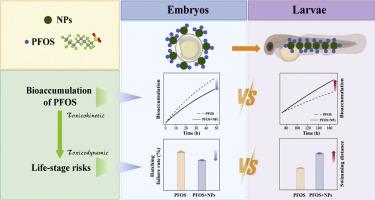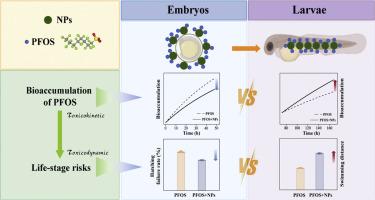Developmental stage-dependent carrier effects of nanoplastics on PFOS bioaccumulation and toxicity in zebrafish: Insights from toxicokinetic-toxicodynamic perspective
IF 12.4
1区 环境科学与生态学
Q1 ENGINEERING, ENVIRONMENTAL
引用次数: 0
Abstract
The long-term coexistence of nanoplastics (NPs) and persistent pollutants like perfluorooctane sulfonate (PFOS) in aquatic ecosystems necessitates an understanding of their combined effects on organisms across different life stages. Here, a toxicokinetic-toxicodynamic (TK-TD) framework was employed to elucidate life stage-dependent mechanisms of NPs-PFOS interactions in zebrafish. At the embryonic stage (0–48 h), the presence of NPs reduced PFOS accumulation by decreasing its bioavailability, consequently mitigating hatching suppression relative to PFOS exposure alone. Conversely, at the larval stage (72–168 h), combined exposure significantly increased PFOS accumulation and exacerbated multilevel toxic effects, including oxidative stress, metabolic dysregulation, disruption of circadian/visual/nervous pathways, and ultimately behavioral deficits (e.g., abnormal swimming). Using the TK model, we quantified the bioaccumulation kinetics modulated by NPs in zebrafish during the embryonic and larval stages. The Bayesian benchmark dose (BBMD) model based on internal concentration indicated no significant alteration of the PFOS dose-response relationship by NPs, implying that the carrier effect of NPs was the primary mechanism driving life stage-specific outcomes. These findings highlight the necessity of investigating life stage-specific risks for NPs-contaminant co-exposure, where NPs transition from toxicity mitigators in embryos to toxicity amplifiers in larvae mediated by carrier effects, as quantified by the TK-TD perspective.


纳米塑料对斑马鱼全氟辛烷磺酸生物积累和毒性的发育阶段依赖载体效应:从毒性动力学-毒性动力学角度的见解
纳米塑料(NPs)与全氟辛烷磺酸(PFOS)等持久性污染物在水生生态系统中长期共存,有必要了解它们在不同生命阶段对生物体的综合影响。本文采用毒性动力学-毒性动力学(TK-TD)框架来阐明斑马鱼NPs-PFOS相互作用的生命阶段依赖机制。在胚胎期(0-48 h), NPs的存在通过降低全氟辛烷磺酸的生物利用度来减少全氟辛烷磺酸的积累,从而减轻了相对于单独暴露全氟辛烷磺酸的孵化抑制。相反,在幼虫期(72-168小时),联合暴露显著增加了全氟辛烷磺酸的积累,并加剧了多层次的毒性作用,包括氧化应激、代谢失调、昼夜/视觉/神经通路的破坏,以及最终的行为缺陷(如异常游泳)。利用TK模型,我们量化了NPs在斑马鱼胚胎期和幼虫期调节的生物积累动力学。基于内浓度的贝叶斯基准剂量(BBMD)模型显示,NPs对PFOS剂量-反应关系没有显著改变,这表明NPs的载体效应是驱动生命阶段特异性结局的主要机制。这些发现强调了研究NPs与污染物共暴露的生命阶段特异性风险的必要性,其中NPs从胚胎的毒性缓解剂转变为载体效应介导的幼虫毒性放大剂,通过TK-TD视角进行量化。
本文章由计算机程序翻译,如有差异,请以英文原文为准。
求助全文
约1分钟内获得全文
求助全文
来源期刊

Water Research
环境科学-工程:环境
CiteScore
20.80
自引率
9.40%
发文量
1307
审稿时长
38 days
期刊介绍:
Water Research, along with its open access companion journal Water Research X, serves as a platform for publishing original research papers covering various aspects of the science and technology related to the anthropogenic water cycle, water quality, and its management worldwide. The audience targeted by the journal comprises biologists, chemical engineers, chemists, civil engineers, environmental engineers, limnologists, and microbiologists. The scope of the journal include:
•Treatment processes for water and wastewaters (municipal, agricultural, industrial, and on-site treatment), including resource recovery and residuals management;
•Urban hydrology including sewer systems, stormwater management, and green infrastructure;
•Drinking water treatment and distribution;
•Potable and non-potable water reuse;
•Sanitation, public health, and risk assessment;
•Anaerobic digestion, solid and hazardous waste management, including source characterization and the effects and control of leachates and gaseous emissions;
•Contaminants (chemical, microbial, anthropogenic particles such as nanoparticles or microplastics) and related water quality sensing, monitoring, fate, and assessment;
•Anthropogenic impacts on inland, tidal, coastal and urban waters, focusing on surface and ground waters, and point and non-point sources of pollution;
•Environmental restoration, linked to surface water, groundwater and groundwater remediation;
•Analysis of the interfaces between sediments and water, and between water and atmosphere, focusing specifically on anthropogenic impacts;
•Mathematical modelling, systems analysis, machine learning, and beneficial use of big data related to the anthropogenic water cycle;
•Socio-economic, policy, and regulations studies.
 求助内容:
求助内容: 应助结果提醒方式:
应助结果提醒方式:


